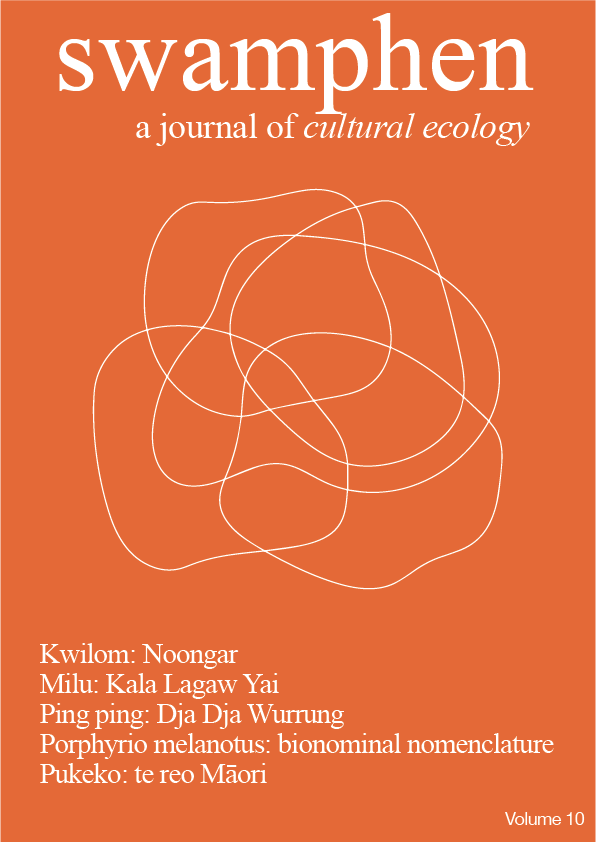Weather under pressure
kin/aesthetic practice and dancerly scores for unstable times
DOI:
https://doi.org/10.60162/swamphen.11.18131Keywords:
kin/aesthetic, writing as dancing, choreographic thinking, improvisation, climate connection, artist-led activismAbstract
This paper will offer a re-scored version of my creative presentation given at Recentring the Region. It is a return of sorts to a methodological dancing body that has been taken up with university mechinacia but is remembering again differently my trust in artists, and trust in knowledges under words, under skins. As an artist, I’m interested in the kind of unquestioned extractivism that artist scholars such as Singer (2023) and van Neervan (2021) write of in the academy, I notice it to. And I think about what artists practice invites, expects, and how it contributes in the ecopoliticalpoetic mix particularly as pertaining to increasing kin/aesthetic attention of human-environment relations. The paper harnesses writing as dancing through a practice of improvisation developed over 20years as a honed kind of staying with leaving (in Place), and as a mode of kin/aesthetic attention to support the urgent need for manifesting connection, climate activism, and care with both immediate and speculative climate futures.
References
Ahmed, Sara. ‘Feminist Ears.’ Bodies of Sound; Becoming a Feminist Ear, edited by Irene Revell and Sarah Shim, Silver Press, 2024.
Alaimo, Stacy and Susan J. Hekman. Material Feminisms. Indiana UP, 2008.
Albright, Ann C. Choreographing Difference: The Body and Identity in Contemporary Dance. Wesleyan UP, 2010.
Anatolitis, Esther. Place, Practice, Politics. AADR – Art Architecture Design Research, 2021.
Brannigan, Erin. Choreography, Visual Art and Experimental Composition 1950s–1970s. Routledge, 2022.
Engleman, Sasha. ‘Weathering Three Storms: Experiments in an Elemental Geohumanities.’ Geohumanities, vol. 9, no. 2, 2023, pp. 1-17.
Laurence, Janet. ‘Spells for Weather.’ Sydney Festival, Jan 29th, 2023, Bundanon. NSW. https://www.bundanon.com.au/whats-on/spells-for-weather/.
Leach, Paea. The Doing of Dancing: Kinaesthetic Attention, Agency and the Dancer. 2020. University of Melbourne, MA thesis.
Musiol, Hanna. ‘Black Ecologies, the “Weather,” and “Renegade” Poetic Sensorium 1.’ Poetry and the Global Climate Crisis: Creative Educational Approaches to Complex Challenges, edited by Amatoritsero Ede, Sandra Lee Kleppe, and Angela Sorby, Routledge, 2024.
Myers, Natasha. ‘Anthropologist as Transducer in the Field.’ Knowings and Knots: Methodologies and Ecologies in Research Creation, edited by Natalie Loveless, University of Alberta Press, 2020.
Neimanis, Astrida. Bodies of Water: Posthuman Feminist Phenomenology. Bloomsbury Publishing, 2017.
Neimanis, Astrida and Jennifer M. Hamilton. ‘Open Space Weathering.’ Feminist Review, vol. 118, April, 2018, pp. 80-84. https://doi.org/10.1057/s41305-018-0097-8.
Paraha, Tru. ‘Astrochoreography.’ Choreographic Practices, vol. 11, no. 2, 2020, pp. 231-244.
Paramaditha, Intan. ‘Radicalising “Learning From Other Resisters” in Decolonial Feminism.’ Feminist Review, vol. 131, no. 1, 2022, pp. 33-49. https://doi.org/10.1177/01417789221102509.
Pigram, Dalisa, Tia Reihana and Rachael Swain. ‘Research Methodologies for Dance and Cultural Dramaturgies in Contested Land.’ Critical Stages/Scènes critiques, no. 28, 2023.
Pollitt, Jo. ‘The State of Dancingness: Staying with Leaving.’ PARtake: The Journal of Performance as Research, vol. 2, no. 2, 2019. https://doi.org/10.33011/partake.v2i2.419.
Pollitt, Jo. ‘She Writes Like She Dances: Response and Radical Impermanence in Writing as Dancing.’ Choreographic Practices, vol. 8, no. 2, 2017, pp. 199-218. https://doi.org/10.1386/chor.8.2.199_1.
Pollitt, Jo. ‘Choreographies of Presence: Improvisation as Feminist Practice.’ Dance Research Methodologies: Ethics, Orientations and Practices, edited by Rosemary Candelario and Matthew Henley, Taylor & Francis, 2023. https://doi.org/10.4324/9781003145615.
Randerson, Janine. Weather as Medium: Toward a Meteorological Art. MIT Press, 2018.
Rich, Adrienne. Collected Poems: 1950-2012. W. W. Norton & Company, 2016.
Rooney, Tonya and Mindy Blaise. Rethinking Environmental Education in a Climate Change Era: Weather Learning in Early Childhood. Taylor & Francis, 2022.
Singer, Hayley. ‘Strange Moon: On Failing to Write a Lecture.’ Substack, 27 June 2023, https://hayleysinger.substack.com/p/strange-moon.
Shiosake, Elfie. “Kin” (Editorial). Cordite Poetry Review, 2022. http://cordite.org.au/essays/kin-editorial/.
Swain, Rachael. Dance in Contested Land: New Intercultural Dramaturgies. Springer Nature, 2020.
van Neerven, Ellen. ‘Tapestries of Poison: (Towards Nurture Writing).’ Swamphen, vol. 10, 2024.
Westle, Andrew. ‘Turning Pointe Gender Equality in Australian Dance.’ Delving into Dance, 2018, www.delvingintodance.com/turning-pointe.
Wright, Sarah. Becoming Weather: Weather, Embodiment and Affect (1st ed.). Routledge, 2024. https://doi.org/10.4324/9781003336297.
Downloads
Published
Issue
Section
License
Authors who publish with this journal agree to the following terms:- Authors retain copyright and grant the journal right of first publication with the work simultaneously licensed under a Creative Commons Attribution License that allows others to share the work with an acknowledgement of the work's authorship and initial publication in this journal.
- Authors are able to enter into separate, additional contractual arrangements for the non-exclusive distribution of the journal's published version of the work (e.g., post it to an institutional repository or publish it in a book), with an acknowledgement of its initial publication in this journal.
- Authors are permitted and encouraged to post their work online (e.g., in institutional repositories or on their website) prior to and during the submission process, as it can lead to productive exchanges, as well as earlier and greater citation of published work (See The Effect of Open Access).

